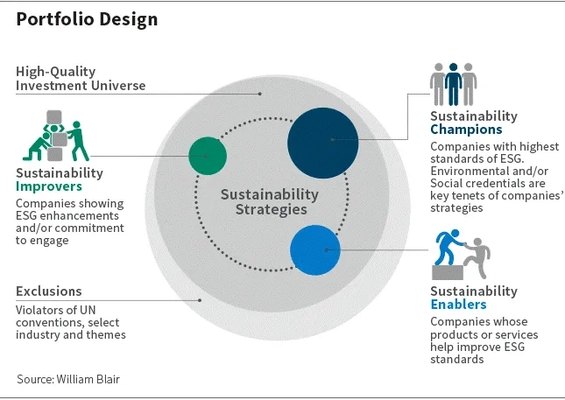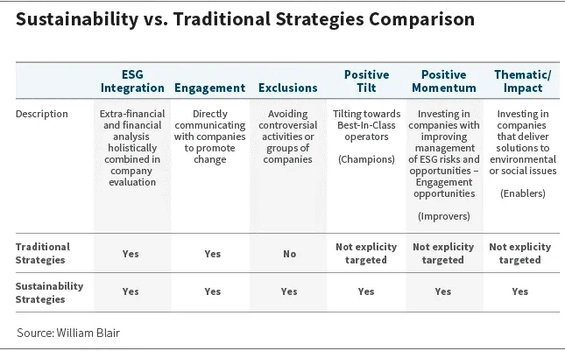This article was originally published on williamblair.com by Tara Patock and Romina Graiver .
Having added dedicated sustainability portfolios to our investment strategy offerings at William Blair, we are often asked about what distinguishes our dedicated sustainability strategies from our traditional strategies, where we believe environmental, social, and governance (ESG) factors are already integrated in our fundamental analysis and portfolio construction process.
As background, we seek to holistically integrate financially material ESG factors into our company analysis for our fundamental equity strategies. We believe this additional lens enhances our perspective around opportunities and risks, as well as the risk-adjusted return profiles of our strategies.
We believe the key distinguishing factor of our dedicated strategies lies in the intentionality of alignment with sustainability goals.
Common Foundation
Our research focus is on financially material ESG factors–or factors that are useful in making investment decisions such as those that are likely to impact a company’s revenues or costs, assets or liabilities, or cost of capital. The integration of these factors alongside other fundamental considerations potentially provides a more holistic perspective of risks and opportunities and informs our assessment of the risk/reward profiles of stocks.
Our ESG analysis manifests in qualitatively driven ESG ratings for the companies in which we invest. Importantly, underlying each rating is rigorous analysis and a unique perspective from our research analysts.
Because we pursue an integrated approach, ESG inputs are taken into consideration at various points in our investment decision-making process, such as identifying additional areas of opportunity, making stock recommendations, and enhancing our understanding of risks. In our traditional strategies, while ESG factors are considered in the company’s assessment, we can invest in high-quality companies where we have identified a durable business model and an attractive risk/reward profile, but where corporate practices or products and services are not necessarily positively aligned with sustainability goals. It’s a mosaic approach.
This is where our dedicated sustainability strategies differ.
Utilizing the same universe of “buy-rated” stocks, additional sustainability criteria are taken into consideration at the portfolio construction phase of our process. We apply our sustainability strategies framework to help ensure that each company in our portfolios is aligned with sustainability goals. Supplementing this proactive alignment, we also apply exclusions around global norms violators and other themes that are generally inconsistent with sustainability objectives.

Intentionally Sustainable
The key distinguishing characteristic of our dedicated sustainability strategies relative to our traditional ESG integration strategies is that companies must also meet at least one of the following three sustainable designations: Sustainability Champions, Sustainability Enablers, or Sustainability Improvers. These categories rely on two distinct perspectives: how companies manage financially material ESG risks and opportunities, and how companies’ products or services align with sustainability outcomes.
Sustainability Champions
Sustainability Champions are companies that operate their businesses in accordance with high ESG standards. They demonstrate strategic management of natural capital, human capital, and stakeholder relationships to deliver long-term value creation. They stand out within their industries as champions of ESG best practices.
An example of a Sustainability Champion would be the world’s largest software company, for which natural resources stewardship has been identified as a material ESG consideration. The company has committed to a science-based target of greenhouse gas (GHG) emissions reduction consistent with a level required to keep warming to 1.5°C. To this end, the company has committed to continue to source 100% renewable electricity, to reduce scope 3 GHG emissions intensity per unit of revenue by 30% by 2030 from a 2017 base year, and to avoid growth in absolute scope 3 emissions.
In order to continue to reduce emissions, the company has a leading internal carbon fee mechanism in place, which was expanded to include emissions from its supply chain. In addition, the company is deploying $1 billion of capital to a Climate Innovation Fund to accelerate the development of carbon reduction and removal technologies as it seeks to become carbon negative.
The company is championing environmental best practices, making it more resilient to potential shocks, while at the same time enhancing the value proposition to its customers, who are increasingly conscious of the environmental impacts of their purchasing decisions.
Sustainability Improvers
Sustainability Improvers are companies that do not have the same best-in-class ESG credentials as Champions but have articulated a clear commitment to advance their ESG practices. We believe company engagement is particularly important in this category to set expectations and evaluate both commitments and progress. We believe companies displaying positive momentum in their ESG practices can unlock value from both a sustainability perspective as well as a portfolio performance perspective.
A good example of a Sustainability Improver is an auto parts retailer that had an employee retention problem due to poor human capital policies. When a new management team came onboard, it revamped the company’s human capital management policies with a focus on diversity and inclusion. In just five years, the company made material progress in terms of the percentage of diverse individuals in management and senior leadership roles. It also improved employee turnover ratios.
This company is transforming the culture from within. It is the right thing to do for the business and its employees, and importantly for shareholders, it is the right thing to do to drive value.
Sustainability Enablers
Sustainability Enablers are companies whose products or services directly contribute to positive societal or environmental outcomes and improvement in the long-term sustainability of the planet. We have defined six broad thematic areas that capture companies we consider Enablers. These are decarbonization, energy efficiency, circular economy, health and well-being, inclusion, and strong institutions.
An example of a Sustainability Enabler is a U.S. small-cap company in the business of “rendering,” which recycles waste parts from animals used in food production. These waste parts—along with fats that have already been used in cooking—are combined to produce renewable biodiesel, which is a fuel that can be put directly into a gas tank. This fuel has some of the lowest carbon scores available because the inputs are not grown for use in fuel but rather are byproducts of other processes.
Not only does this company enable a more circular economy, it also helps certain jurisdictions meet low-carbon fuel goals until electric vehicles become more mainstream and as cars that use internal combustion engines are slowly phased out of use.
Another example of a Sustainability Enabler in the inclusion theme is a large-cap platform business in emerging markets. The company’s core marketplace enables small to midsize enterprises (SMEs) to move online, which proved particularly crucial for SMEs’ survival during the COVID-19 pandemic and is expected to continue to play a positive role in the socioeconomic development of these countries. Moreover, its payments solutions focus on the unbanked population across Latin America, hence promoting a financial inclusion outcome.

No Concessions Needed
As a result of our bottom-up process focused on building portfolios around these criteria, our sustainability strategies typically display robust ESG credentials and an organic alignment with sustainability themes. For example, we have a number of holdings that contribute to decarbonization, which many consider the most important theme related to sustainability strategies because our society is in a race against time to reach net zero.
Other themes that are evident within the portfolios include the circular economy, energy efficiency, human health improvement, inclusion, and strong institutions. These themes are broadly aligned with several United Nations Sustainable Development Goals (SDGs); as a result, over time, portfolios are likely to have companies that contribute to many of the SDGs.
There is a concept in sustainable investing called concessionary capital, whereby investors accept lesser returns in exchange for having an impact on ESG considerations. Increasingly, however, there is evidence that such a concession is unnecessary. One can create alpha over the long term through good stock selection while contributing to more sustainable outcomes.
The bottom line: We don’t think there is a tradeoff between capturing alpha for clients, which is our core mission, and aligning our dedicated sustainability strategies with these longer-term sustainability goals.

